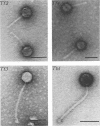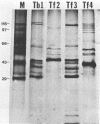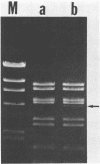Abstract
Bacteriophages lysing strains of Thermomonospora alba and T. fusca were isolated, following specific enrichment, from vegetable composts. Four Thermomonospora phages were distinguished by plaque morphology and host range. Electron microscopy of phage particles, termperature inactivation profiles, and electrophoretic analyses of major virion proteins and genomic DNA were used in the comparison and initial characterization of these phages. The four phages studied possessed polyhedral heads and long tails; genomes were linear double-stranded DNA molecules, 35 to 45 kilobases in length, which probably contain cohesive ends. Transfection of Thermomonospora protoplasts with purified genomic DNA from one of the phages was demonstrated.
Full text
PDF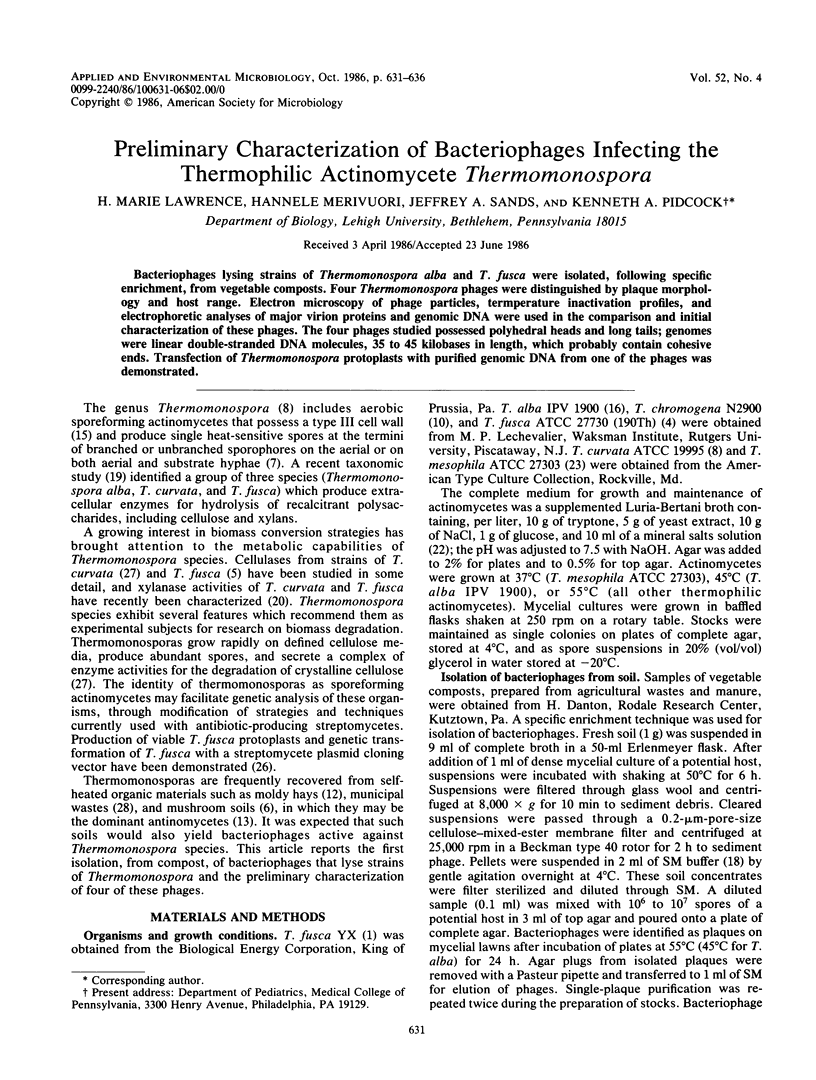
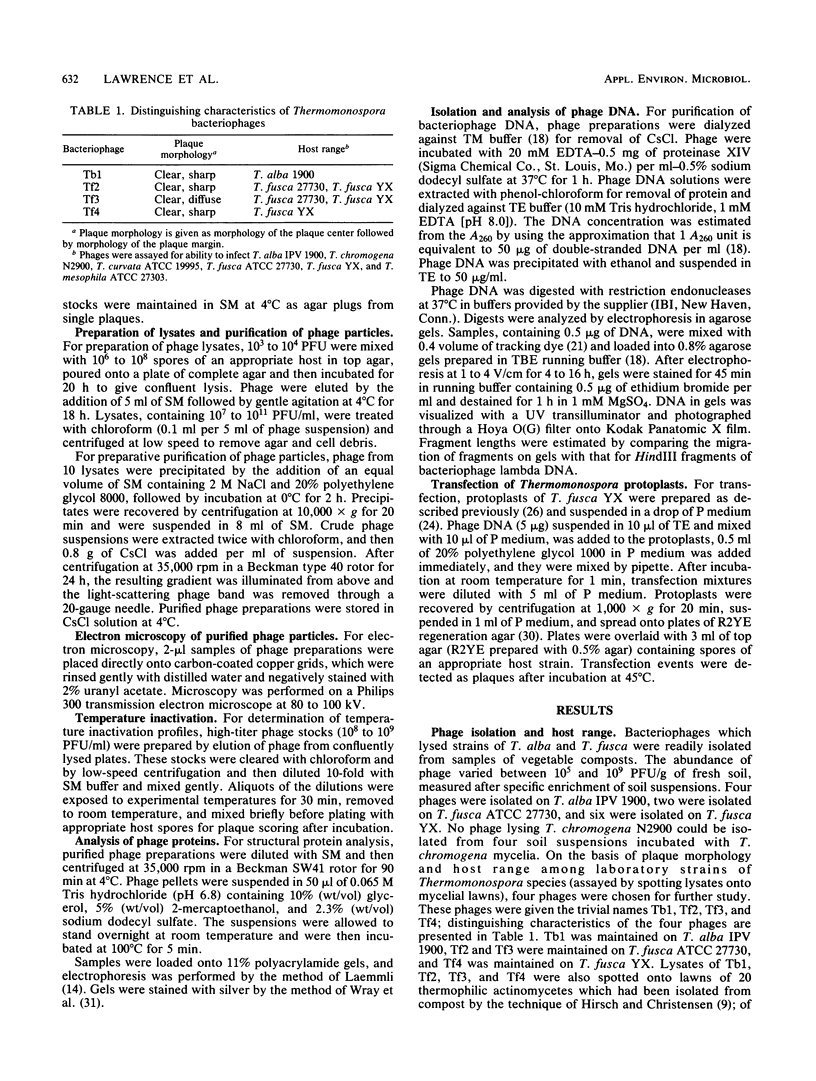
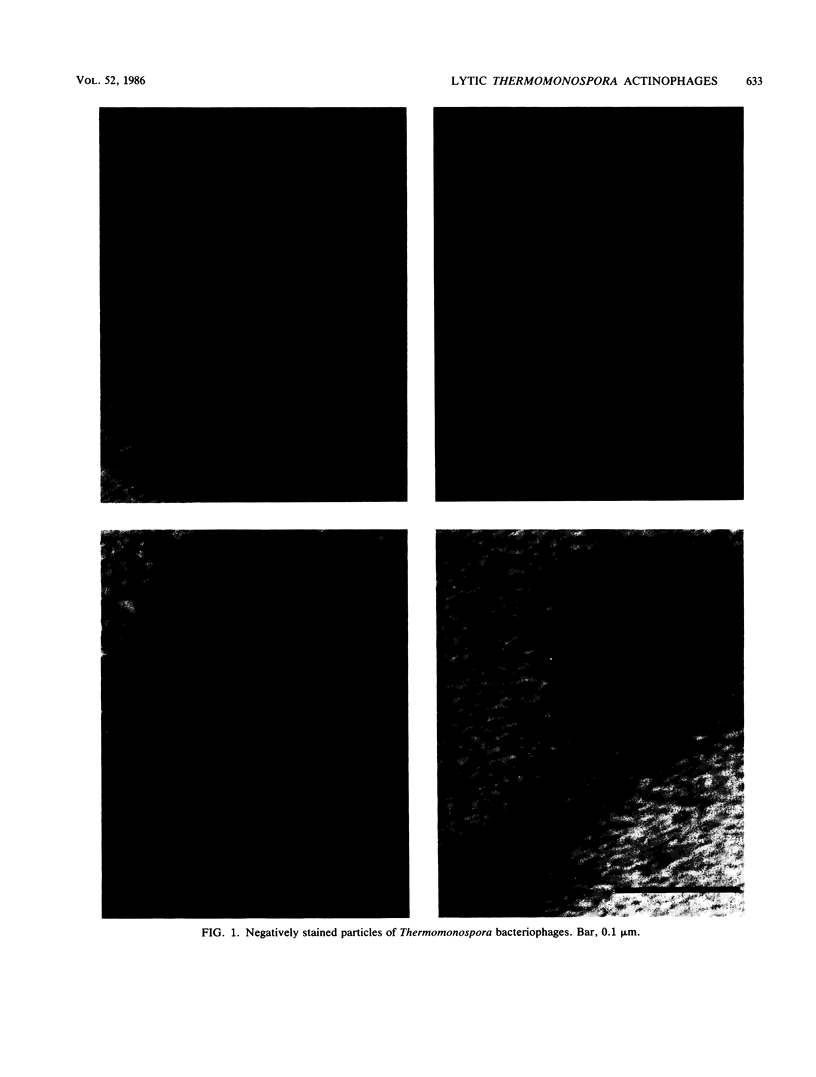
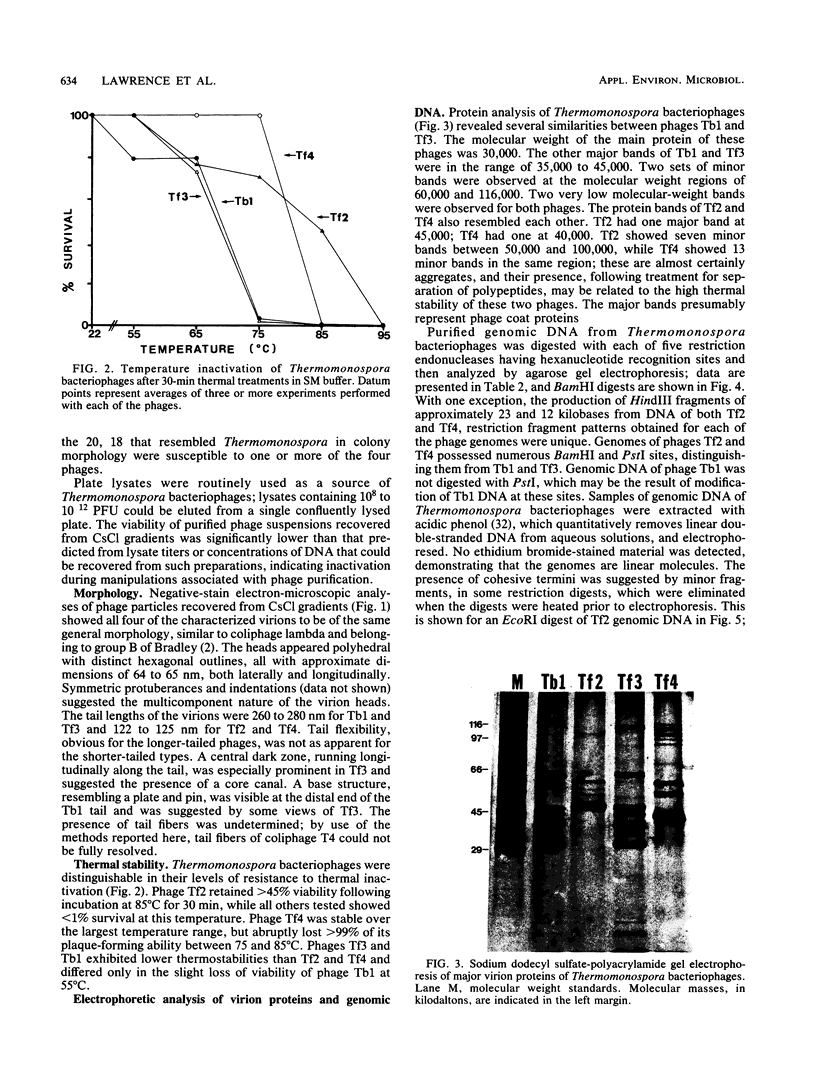
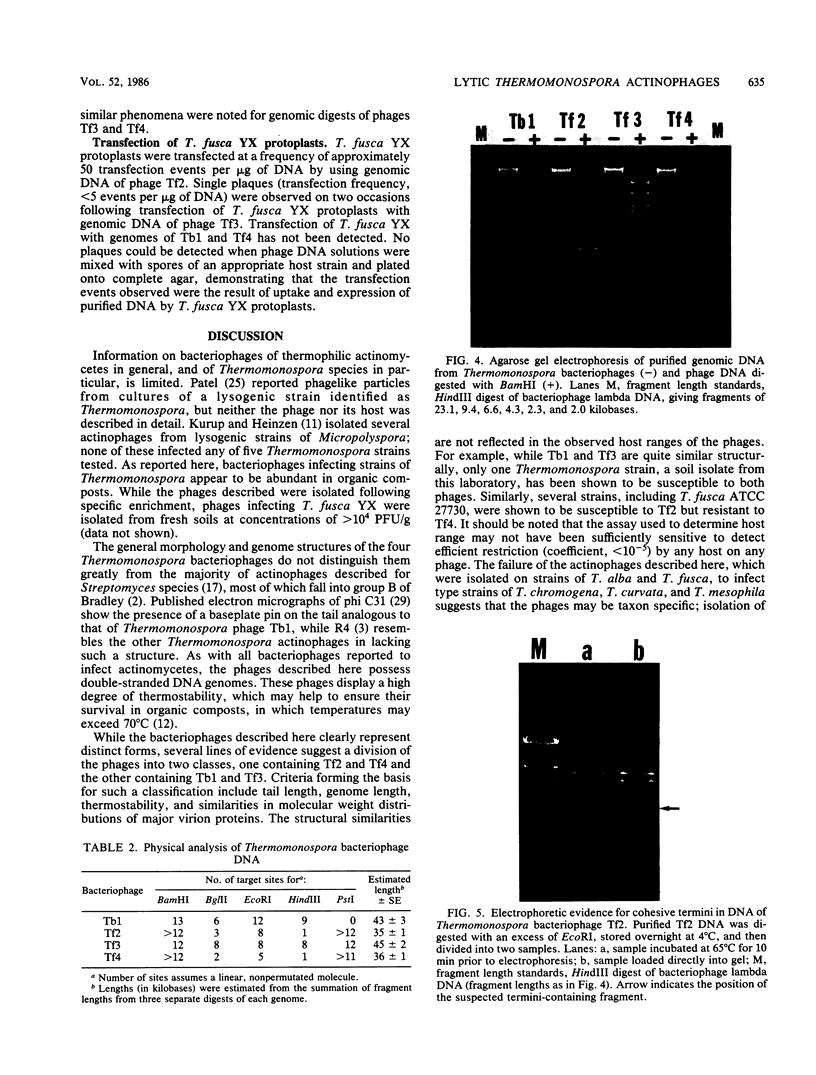
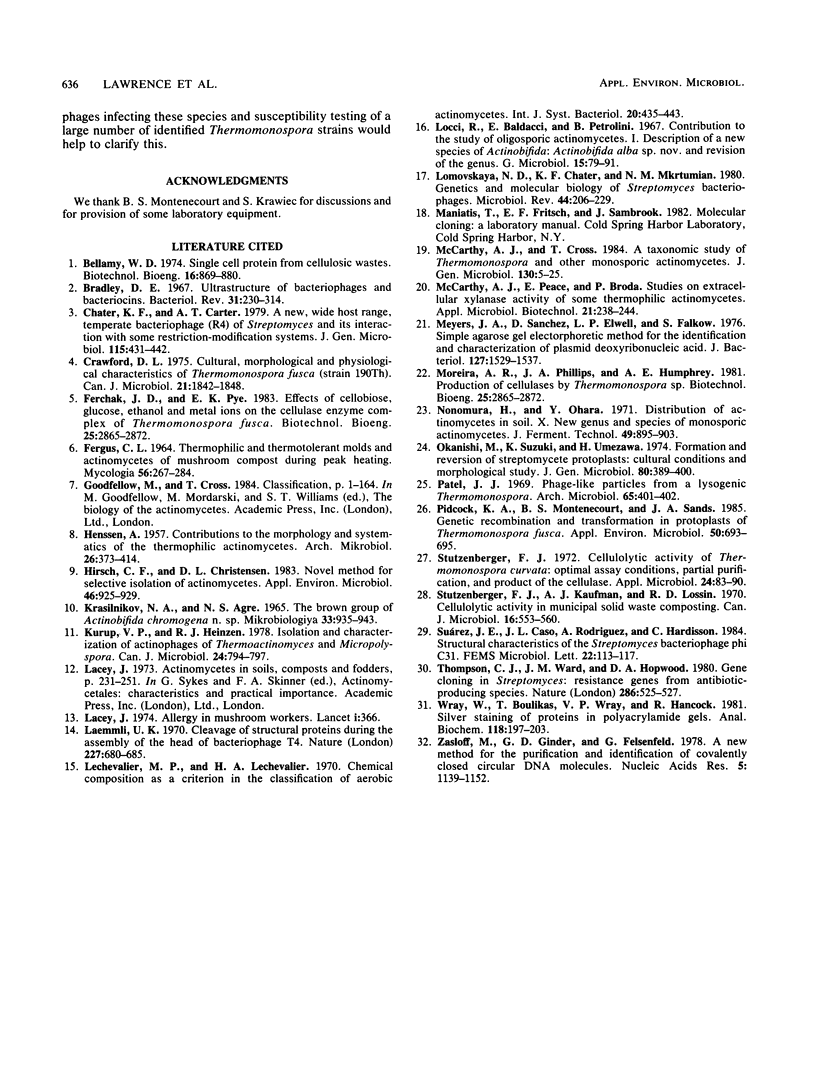
Images in this article
Selected References
These references are in PubMed. This may not be the complete list of references from this article.
- Bellamy W. D. Biotechnology report: single cell proteins from cellulosic wastes. Biotechnol Bioeng. 1974 Jul;16(7):869–880. doi: 10.1002/bit.260160702. [DOI] [PubMed] [Google Scholar]
- Bradley D. E. Ultrastructure of bacteriophage and bacteriocins. Bacteriol Rev. 1967 Dec;31(4):230–314. doi: 10.1128/br.31.4.230-314.1967. [DOI] [PMC free article] [PubMed] [Google Scholar]
- Crawford D. L. Cultural, morphological, and physiological characteristics of Thermomonospora fusca (strain 190Th). Can J Microbiol. 1975 Nov;21(11):1842–1848. doi: 10.1139/m75-267. [DOI] [PubMed] [Google Scholar]
- HENSSEN A. Beiträge zur Morphologie und Systematik der thermophilen Actinomyceten. Arch Mikrobiol. 1957;26(4):373–414. [PubMed] [Google Scholar]
- Hirsch C. F., Christensen D. L. Novel method for selective isolation of actinomycetes. Appl Environ Microbiol. 1983 Oct;46(4):925–929. doi: 10.1128/aem.46.4.925-929.1983. [DOI] [PMC free article] [PubMed] [Google Scholar]
- KRASILNIKOV N. A. NOVY I ROD LUCHISTYKH GRIBKOV--ACTINOBIFIDA N. GEN. ZHELTAIA GRUPPA--ACTINOBIFIDA DICHOTOMICA N. SP. Mikrobiologiia. 1964 Nov-Dec;33:935–943. [PubMed] [Google Scholar]
- Kurup V. P., Heinzen R. J. Isolation anc characterization of actinophages of Thermoactinomyces and Micropolyspora. Can J Microbiol. 1978 Jul;24(7):794–797. doi: 10.1139/m78-133. [DOI] [PubMed] [Google Scholar]
- Lacey J. Actinomycetes in soils, composts and fodders. Soc Appl Bacteriol Symp Ser. 1973 Jan;2:231–251. [PubMed] [Google Scholar]
- Lacey J. Letter: Allergy in mushroom workers. Lancet. 1974 Mar 2;1(7853):366–366. doi: 10.1016/s0140-6736(74)93133-x. [DOI] [PubMed] [Google Scholar]
- Laemmli U. K. Cleavage of structural proteins during the assembly of the head of bacteriophage T4. Nature. 1970 Aug 15;227(5259):680–685. doi: 10.1038/227680a0. [DOI] [PubMed] [Google Scholar]
- Lomovskaya N. D., Chater K. F., Mkrtumian N. M. Genetics and molecular biology of Streptomyces bacteriophages. Microbiol Rev. 1980 Jun;44(2):206–229. doi: 10.1128/mr.44.2.206-229.1980. [DOI] [PMC free article] [PubMed] [Google Scholar]
- Meyers J. A., Sanchez D., Elwell L. P., Falkow S. Simple agarose gel electrophoretic method for the identification and characterization of plasmid deoxyribonucleic acid. J Bacteriol. 1976 Sep;127(3):1529–1537. doi: 10.1128/jb.127.3.1529-1537.1976. [DOI] [PMC free article] [PubMed] [Google Scholar]
- Okanishi M., Suzuki K., Umezawa H. Formation and reversion of Streptomycete protoplasts: cultural condition and morphological study. J Gen Microbiol. 1974 Feb;80(2):389–400. doi: 10.1099/00221287-80-2-389. [DOI] [PubMed] [Google Scholar]
- Patel J. J. Phage-like particles from a lysogenic Thermomonospora. Arch Mikrobiol. 1969;65(4):401–402. doi: 10.1007/BF00412217. [DOI] [PubMed] [Google Scholar]
- Pidcock K. A., Montenecourt B. S., Sands J. A. Genetic Recombination and Transformation in Protoplasts of Thermomonospora fusca. Appl Environ Microbiol. 1985 Sep;50(3):693–695. doi: 10.1128/aem.50.3.693-695.1985. [DOI] [PMC free article] [PubMed] [Google Scholar]
- Stutzenberger F. J. Cellulolytic activity of Thermomonospora curvata: optimal assay conditions, partial purification, and product of the cellulase. Appl Microbiol. 1972 Jul;24(1):83–90. doi: 10.1128/am.24.1.83-90.1972. [DOI] [PMC free article] [PubMed] [Google Scholar]
- Stutzenberger F. J., Kaufman A. J., Lossin R. D. Cellulolytic activity in municipal solid waste composting. Can J Microbiol. 1970 Jul;16(7):553–560. doi: 10.1139/m70-093. [DOI] [PubMed] [Google Scholar]
- Thompson C. J., Ward J. M., Hopwood D. A. DNA cloning in Streptomyces: resistance genes from antibiotic-producing species. Nature. 1980 Jul 31;286(5772):525–527. doi: 10.1038/286525a0. [DOI] [PubMed] [Google Scholar]
- Wray W., Boulikas T., Wray V. P., Hancock R. Silver staining of proteins in polyacrylamide gels. Anal Biochem. 1981 Nov 15;118(1):197–203. doi: 10.1016/0003-2697(81)90179-2. [DOI] [PubMed] [Google Scholar]
- Zasloff M., Ginder G. D., Felsenfeld G. A new method for the purification and identification of covalently closed circular DNA molcules. Nucleic Acids Res. 1978 Apr;5(4):1139–1152. doi: 10.1093/nar/5.4.1139. [DOI] [PMC free article] [PubMed] [Google Scholar]



